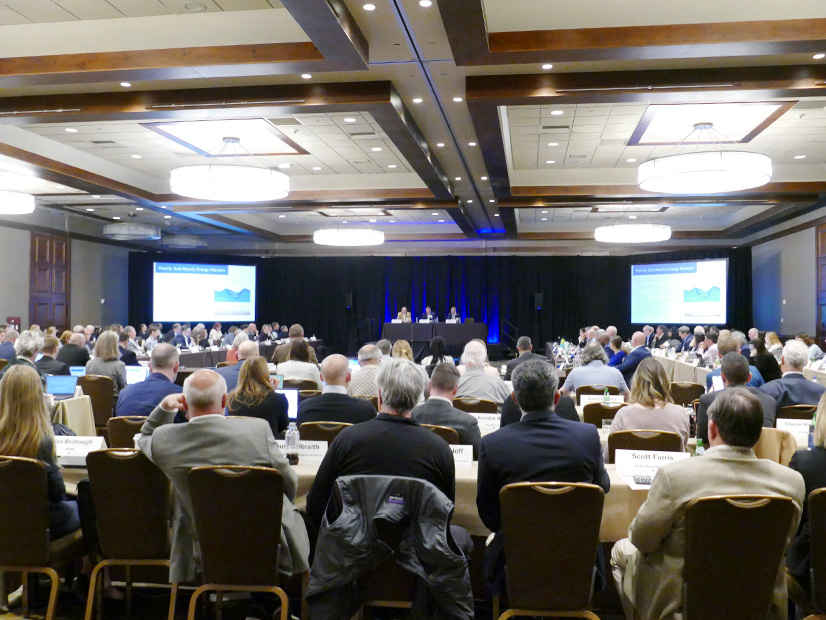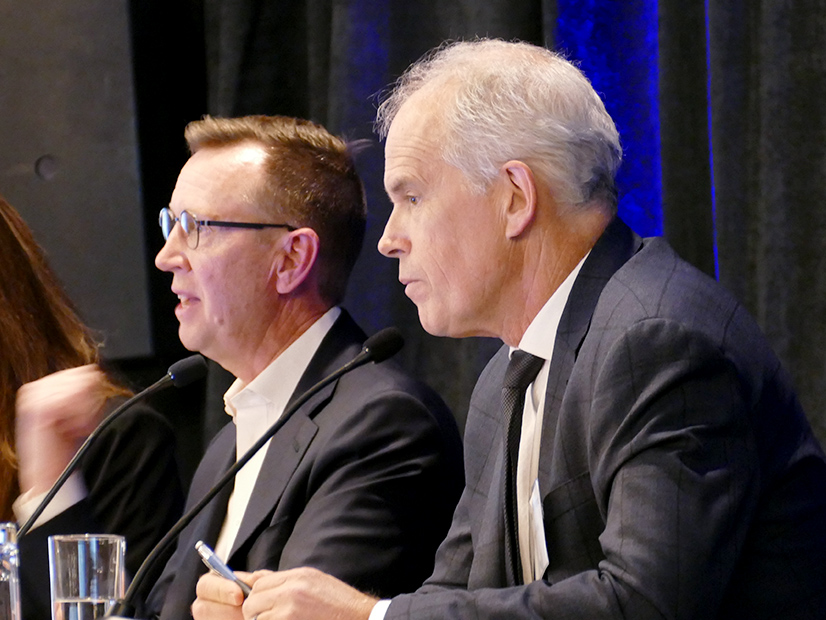
INCLINE VILLAGE, Nev. — Speakers debated whether the West would benefit more from the one day-ahead market run by CAISO or with another run by SPP at last week’s meeting of the Committee on Regional Electric Power Cooperation and the Western Interconnection Regional Advisory Body.
The spring CREPC-WIRAB meeting took place as CAISO is drafting tariff language to add an extended day-ahead market (EDAM) to its real-time Western Energy Imbalance Market (WEIM) and SPP is developing its Markets+ program with a day-ahead market as its centerpiece. (See SPP: 31 Entities Join in Markets+ Development.)
Advocates for a CAISO-led day-ahead market and others backing SPP spoke on two panels Wednesday at the Hyatt Regency Lake Tahoe Resort, where Western regulators and stakeholders filled a large meeting room to capacity.
 Ric O’Connell, GridLab | © RTO Insider LLC
Ric O’Connell, GridLab | © RTO Insider LLC“Markets give us affordable and reliable energy through breadth, depth and transparency,” said Ric O’Connell, executive director of GridLab, a nonprofit technical advisory firm in Berkeley, California. “We need a market that’s broad enough to capture resource and load diversity, and we need a market that’s deep and liquid so that there’s a lot of energy traded in that market, either in real-time or in the day-ahead.”
A Western day-ahead market without California would lack those attributes, O’Connell said.
“California has close to half the load of the West,” he said. “California has massive transmission connections both to the Pacific Northwest and to the Desert Southwest, and it’s been trading with [entities in those regions] for decades … so I would posit that a Western market that does not include California is going to lack the breadth and depth that we need to unlock the benefits of affordable and reliable energy in the West.”
The Western Energy Imbalance Market encompasses 80% of load in the Western Interconnection and has achieved $3.4 billion in benefits for its participants, including $1.5 billion last year alone, he said.
“We have huge potential to increase those benefits if we move to a day-ahead market that covers that same 80%,” and even more if CAISO were to lead a Western RTO, he said.
Having two markets in the West and bifurcating those benefits would be a step backward, O’Connell said.
‘A Swiss Cheese Universe’
In a subsequent panel, Stefan Bird, CEO of PacifiCorp division Pacific Power said the benefits of CAISO’s WEIM are proven and substantial.
PacifiCorp co-founded the interstate trading market with CAISO in 2014 and was the first utility to commit to joining EDAM in December. The utility serves 2 million customers in California, Idaho, Oregon, Utah, Washington and Wyoming. (See PacifiCorp to Join EDAM, Final Plan Released.) The company is so far not among the 31 utilities and industry groups that have officially signed on to SPP’s effort to develop a Western market.
“It doesn’t matter if we’re in our red states or blue states. We save money, improve reliability and reduce emissions [through the WEIM],” Bird said. “It’s not theory. This is the real deal.”
PacifiCorp has derived nearly $600 million in benefits as a WEIM participant, much of it by buying cheap solar power from California and other Western states, he said.
“Prior to the EIM existing, we wouldn’t have been able to take advantage of all that low-cost solar that was being deployed very rapidly in California [without] enough load in California to use it all,” Bird said. “The alternative in California was to curtail it. But for the EIM being able to trade very rapidly intra-hour — as opposed to the old days [when grid operators would] pick up the phone and try to make trades on an hourly basis — that simply wasn’t possible.”
PacifiCorp has reduced its greenhouse gas emissions by 42.6 million metric tons since 2014 because it does not need to run its fossil fuel-burning plants as much when renewable power is available through the WEIM, he said.
“The morning sun comes up with all that solar energy in Utah and southern Oregon and California, Bird said. “We’re taking every bit of it we can, and we back off our coal fleet, our gas fleet. We’re not incurring those fuel costs. We’re not burning the emissions, and we save our customers money.”
“We don’t want to see those benefits disappear or get broken, and that’s precisely what’s being contemplated in a separate [SPP day-ahead] market that would be created on top of [the WEIM’s] footprint,” Bird said.
Having two day-ahead markets in the West would produce seams problems between balancing areas and provoke “situations of conflict where a peace treaty has got to be negotiated, and that’s going to take years,” he said.
It would be “a Swiss cheese universe that I think would really put a dent in those [WEIM market] benefits that are most important to us,” Bird said.
Independent Governance
Tom Bechard, CEO of Canadian energy marketer Powerex, said the seams issue was being overblown by those in favor of a CAISO-led day-ahead market. Powerex has been a WEIM member since 2018, but Bechard’s comments reflected a preference for SPP’s Markets+.
“There are some people in the room who are putting seams coordination first,” Bechard said. “I think that’s really kind of a misplaced priority. The [dialogue] I’m hearing about seams seems to be more fear-based than fact-based. And I know for a fact that seams can be managed efficiently through joint operating agreements.”
A higher priority for those weighing day-ahead markets should be governance, Bechard said. He recommended a model resembling SPP’s governance structure.
 Pacific Power CEO Stefan Bird (left) and Powerex CEO Tom Blechard debated the merits of day-ahead markets being developed by CAISO and SPP. | © RTO Insider LLC
Pacific Power CEO Stefan Bird (left) and Powerex CEO Tom Blechard debated the merits of day-ahead markets being developed by CAISO and SPP. | © RTO Insider LLC
“It is not just an independent board that’s required,” Bechard said. “You need to have stakeholders with voting rights, and you need to have an impartial operator. Having stakeholders with voting rights ensures that it’s the stakeholders that determine what goes to the board rather than the market-operator staff. And having an impartial operator ensures that the operator is not subject to undue influence from any particular state or set of states.”
SPP has an independent board, a committee of state regulators and stakeholder groups that develop and vet policy proposals. It plans to apply the same governance structure to Markets+.
CAISO staff and management develop policy proposals with stakeholder input. The ISO is led by a Board of Governors appointed by the California governor and confirmed by the state Senate, resulting in all of its members being Californians. A legislative effort is underway to open the board to out-of-state members so CAISO can become an RTO. (See Lawmaker Introduces Bill to Turn CAISO into RTO.)
The WEIM Governing Body includes members from outside California and shares joint authority with the ISO Board of Governors over matters affecting the interstate market. EDAM also would be governed under a joint-authority model.
‘Grid of the Future’
Bechard contended that an SPP day-ahead market could offer greater benefits in the future through resource diversity, assuming new interregional transmission lines connecting it to the Pacific Northwest get built.
When envisioning a day-ahead market, “we shouldn’t be thinking about the grid that we have today,” he said. “We should be thinking of the grid of the future.”
As more solar comes online in the Desert Southwest and California and thermal generators retire, resource diversity and trading benefits between the regions will diminish, he said.
“They’re going to have the same resources, the same load, the same issues with solar oversupply and evening ramp and net peak load,” Bechard said. “We see that opportunity to trade between those markets declining.”
Resource diversity and economic value between the Pacific Northwest and SPP will be greater, he said. The Northwest has large amounts of hydropower, and SPP has 30 GW of wind power in an area with weather patterns and peak demand times different from the West’s, he said.
Bechard cited a Lawrence Berkeley National Laboratory report that showed some of the nation’s highest-value transmission lines could be built linking SPP to the West, alleviating congestion and allowing resource transfers. (See Lawrence Berkeley Lab Sees New Transmission Value Spike in 2022.)
If the 31 entities that have signed on for the development phase of SPP’s Markets+ program continue to its operational phase, the market would have a 50 GW peak load, he said.
California has a 54 GW peak load, so if CAISO were a separate market, there would be “two big markets … optimizing within their footprints” and potentially engaging in “robust and automated trade” in the day-ahead time frame, he said.
“It’s much better than the status quo,” Bechard said. “And it’s definitely not a step back from what we have today.”
